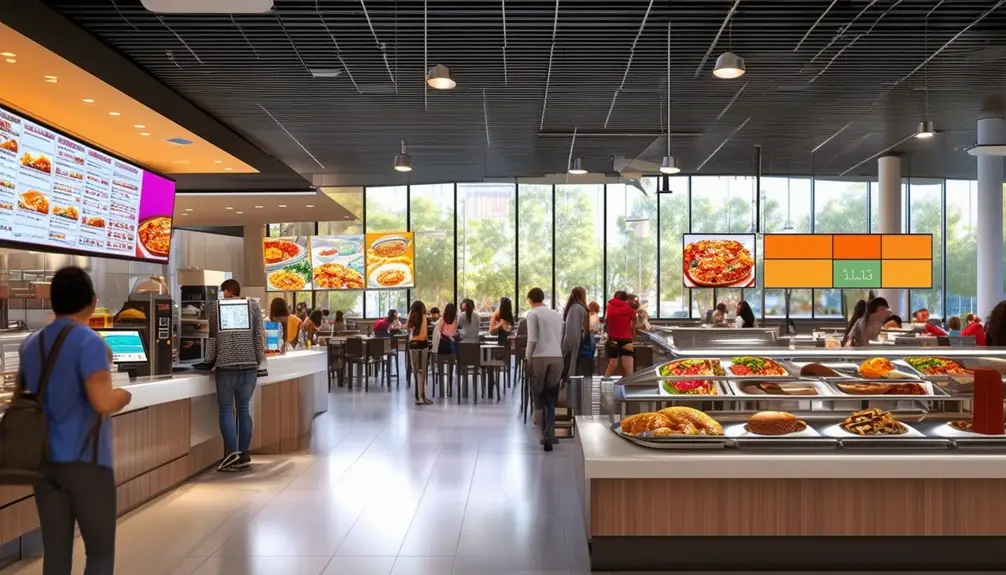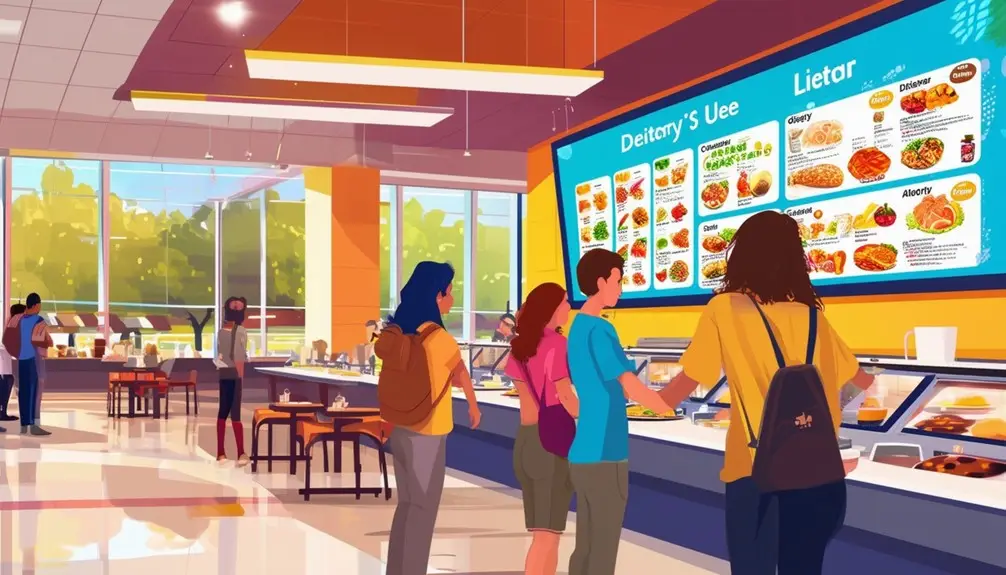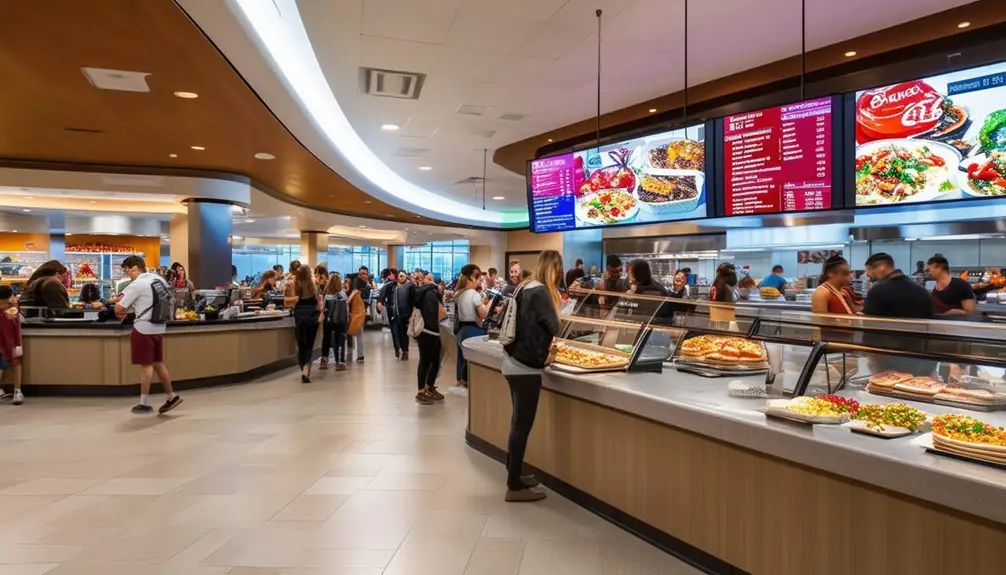Upgrade your college cafeteria with digital menu solutions that prioritize health and safety. Digital menus allow for quick updates, ensuring accurate information for students. You can customize lighting and contrast for better readability and display detailed nutritional info, ingredients, and allergen lists. Manage menus remotely and efficiently through user-friendly templates. Subscription-based hardware keeps costs down while enhancing worker safety by reducing manual changes. These solutions not only streamline communication and enhance visibility but also meet students’ preferences for price and description details. Discover how you can optimize your cafeteria operations and meet student needs seamlessly.
Key Takeaways
- Digital menus offer quick updates, ensuring accurate and real-time menu information.
- Templates simplify remote menu customization and management from any location.
- Digital menus improve visibility and readability with customizable lighting and contrast for students.
- Display detailed menu information including prices, descriptions, nutritional details, and allergens to meet student preferences.
- Enhance communication efficiency and campus engagement with dynamic and instantly updated digital content.
Benefits of Digital Menus
Digital menus in college cafeterias offer numerous health and operational benefits by providing quick updates, ensuring accurate information, and enhancing visibility for students. Digital menu boards make it easy to keep information current. You won’t have to worry about outdated or incorrect menu items causing confusion. Mistakes can be corrected swiftly, ensuring that students always have access to accurate nutritional information and dietary options.
One of the standout features of digital menus is their readability. Customizable lighting and contrast settings make the boards easy to read, even in various lighting conditions. This is particularly beneficial for students with visual impairments or those who simply need clear, legible text to make quick decisions during busy meal times.
Digital menus can display different items throughout the day thanks to dayparting capabilities. This means breakfast, lunch, and dinner menus can automatically update without any manual intervention, catering to the diverse preferences of the student body. Additionally, by eliminating the need for physical menu changes, digital menus enhance worker safety by reducing contact with potentially contaminated surfaces. Overall, digital menu boards make it easy to maintain a healthy, efficient, and safe dining environment.
Zoney Features
When considering the health benefits and operational efficiencies of digital menus, Zoney stands out with its robust features designed to streamline menu management in college cafeterias. With Zoney’s digital signage software, you can create and edit menus remotely, guaranteeing that updates are seamless and timely without the need for physical presence. This feature is particularly advantageous for maintaining accurate nutritional information and allergen alerts, which are vital for the well-being of students.
Offers easy-to-use templates and tools that help you customize menus to meet specific dietary policies and preferences. This digital signage software allows for multiple menu management from any location, making it simple to update breakfast, lunch, and dinner options across various cafeterias simultaneously. The platform’s requirement for internet connectivity ensures that all menu changes are implemented in real-time, promoting consistency and reliability.
The deployment and maintenance of digital menus are further simplified with their Media Player Hardware as a Service subscription model. This makes it easy to manage hardware without the need for significant upfront investment or technical expertise. By leveraging these features, you can guarantee your cafeteria operates efficiently while prioritizing students’ health and dietary needs.
Recommended Hardware

Implementing Media Player Hardware guarantees your college cafeteria’s digital menu boards are both cost-effective and easy to manage. With these subscription-based models, you eliminate the hefty upfront costs, making state-of-the-art digital signage accessible and sustainable. These services also include all-encompassing management and support, ensuring your digital menu boards run smoothly and efficiently.
The digital signage software allows for seamless updates and real-time adjustments, making it simple to tweak menu items or display nutritional information. With internet connectivity as a prerequisite, you can manage your digital signage remotely, providing flexibility and convenience.
Adopting these hardware solutions also enhances worker safety. By reducing the need for manual menu changes, you minimize physical strain and potential accidents. However, note that the availability of Rise Vision and Avocor R Series hardware is currently limited to the United States.
Choosing these recommended hardware options not only simplifies menu management but also supports a healthier, safer work environment. Your digital signage will be more than just menus; it will be a dynamic, easily manageable tool that promotes both operational efficiency and worker well-being.
How to Get Started
Ready to transform your college cafeteria’s menu system? Start by signing up for an account, which will allow you to easily create and manage your digital menu board solution. With professionally designed templates, you can customize them to match your cafeteria’s branding requirements, securing a polished and cohesive look.
To keep your displays engaging and up-to-date, you can access new menu templates weekly. This secures your menu content stays fresh and appealing. For more advanced features, consider using Zoney’s cloud-based software. This platform enables you to design, edit, and manage menus efficiently, incorporating advanced day-parting features to display different menu items based on the day of the week or time of day.
Student Preferences
When considering student preferences, you’ll find that around 35% of students favor digital menu boards for their convenience. Many prioritize seeing price information, with over 50% ranking it as a key factor, and 40% valuing detailed descriptions. To meet health and policy standards, guarantee your digital menus include photos, nutritional details, ingredient lists, and allergen information, which are essential for 25-33% of the student body.
Popular Menu Features
Price transparency and detailed descriptions are at the forefront of student preferences for digital menu boards in college cafeterias. Nearly 30% of students prioritize price on menu signage, with over 50% ranking it in their top two choices. When you’re looking at digital menus, you want to see clear prices to manage your budget effectively. Detailed descriptions are essential for about 40% of students, helping you understand exactly what you’re ordering.
Photos, nutrition details, ingredient lists, and allergen information are valued by 25-33% of students. These elements allow you to make informed, health-conscious choices. You can quickly identify whether a dish meets your dietary needs or preferences. Over 70% of students find detailed menu boards important, emphasizing the significance of thorough digital menus in making dining decisions.
Mobile ordering is another key feature that complements digital menu boards. When you’re on the go, the ability to order from your phone enhances convenience and guarantees quicker service. By integrating detailed menu information with mobile ordering, college cafeterias can meet your health-focused needs and preferences, providing a seamless dining experience that’s transparent, informative, and efficient.
Digital Menu Accessibility
Understanding the importance of detailed menu features, students also prioritize the accessibility of these digital menus to enhance their dining experience. As a student, you likely value digital dining options that are easy to navigate and rich in information. With 50% of students prioritizing online menus, it’s clear that having access to digital signage and mobile ordering apps can streamline your meal choices.
You probably appreciate menu components that provide extensive details like item prices, food descriptions, photos, nutrition details, ingredient lists, and allergen information. These elements are vital for making informed decisions, especially if you have specific dietary needs or preferences. Over 70% of students find menu boards important, underscoring the need for well-designed digital signage in college cafeterias.
Price transparency is also a key factor, with nearly 30% of students prioritizing it on menu signage and over 50% ranking it in their top two choices. By ensuring that digital dining solutions incorporate these detailed menu components, your college cafeteria can greatly enhance your dining experience. Extensive digital menus not only aid in decision-making but also contribute to a more satisfying and health-conscious dining environment.
Information Display Preferences
To cater to student preferences, college cafeterias should prioritize displaying detailed information on digital menus, including prices, food descriptions, and nutritional content. Doing so, you help students make informed choices that align with their dietary needs and budget constraints.
Students prioritize various menu components, and understanding these preferences is vital. Here’s a breakdown:
| Menu Component | Student Preference (%) |
|---|---|
| Prices | 50% |
| Food Descriptions | 40% |
| Nutrition Details | 33% |
Digital menus offer a thorough platform to showcase these components effectively. Over 50% of students rank price as one of their top two choices, making it necessary to feature prominently. Descriptions and nutrition details are also essential, as they help students understand what they’re eating and how it fits into their health goals.
Digital menus should incorporate ingredient lists and allergen information, catering to the 25-33% of students who value these details. Utilizing digital signage allows for dynamic content updates, ensuring that all information is current and accurate. By aligning with student preferences, you enhance their dining experience and support informed, healthier choices.
Enhancing Communication

Digital menu boards in college cafeterias streamline communication by instantly delivering up-to-date information to students and faculty, enhancing overall campus engagement and navigation. These boards are vital in improving communication efficiency, ensuring that essential updates, such as daily menus and special announcements, reach everyone promptly. With the ability to display tailored messages, they can target specific audiences, making the communication more relevant and effective.
For instance, digital signage can guide new students through campus navigation, helping them locate dining halls or special dietary options. It also allows for swift updates, ensuring that any changes in menu items or meal schedules are immediately visible. This real-time communication is essential for maintaining dietary health and safety standards, particularly for students with specific nutritional needs or allergies.
Using templates for events and announcements on these boards further enhances communication efficiency. You can easily update and schedule content, ensuring that all campus activities, from health workshops to social events, are well-publicized. By modernizing communication tools with digital signage, colleges not only improve operational efficiency but also foster a more engaged and informed student body, ultimately creating a healthier campus environment.
Conclusion
Wrapping up, think of digital menus as the heartbeat of a modern college cafeteria, keeping everything running smoothly. Adopting the recommended hardware will meet student preferences and enhance communication seamlessly. Immerse yourself in this health-focused solution today; it’s policy-aware and detail-oriented, ensuring you stay ahead of the curve. Ready to transform your cafeteria experience? Make the switch and watch your dining services thrive.
Frequently Asked Questions
How Much Does a Digital Menu Cost?
You’ll typically pay at least $10 a month for a digital menu, but costs can rise with extra features like dynamic content. Don’t forget to factor in hardware and support services for the total expense.
How to Turn TV Into Menu Board?
Think of your TV as a blank canvas. With Zoney, you can quickly transform it into a dynamic, digital menu board. Use the cloud-based software to design, edit, and manage the display, ensuring compliance with health regulations.
How Do Digital Menu Boards Work?
Digital menu boards operate by showcasing dynamic menus on screens, remotely managed for quick updates. They can be personalized and incorporate dayparting, enhancing visibility and engagement. This guarantees you’re providing clear, health-focused menu information efficiently.
How Does a Digital Menu App Add Value to Your Restaurant Business?
A digital menu app boosts your restaurant’s revenue by up to 30%, enhances customer satisfaction by reducing wait times by 35%, and cuts printing costs by 25%. Customers also find them easier to read and navigate.





